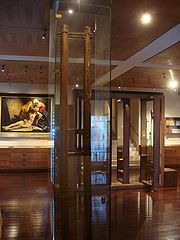
Cangue
Encyclopedia

Public humiliation
Public humiliation was often used by local communities to punish minor and petty criminals before the age of large, modern prisons .- Shameful exposure :...
and corporal punishment
Corporal punishment
Corporal punishment is a form of physical punishment that involves the deliberate infliction of pain as retribution for an offence, or for the purpose of disciplining or reforming a wrongdoer, or to deter attitudes or behaviour deemed unacceptable...
in China
China
Chinese civilization may refer to:* China for more general discussion of the country.* Chinese culture* Greater China, the transnational community of ethnic Chinese.* History of China* Sinosphere, the area historically affected by Chinese culture...
and some other parts of East Asia
East Asia
East Asia or Eastern Asia is a subregion of Asia that can be defined in either geographical or cultural terms...
and Southeast Asia
Southeast Asia
Southeast Asia, South-East Asia, South East Asia or Southeastern Asia is a subregion of Asia, consisting of the countries that are geographically south of China, east of India, west of New Guinea and north of Australia. The region lies on the intersection of geological plates, with heavy seismic...
, until the early years of the twentieth century.
It was similar to the pillory
Pillory
The pillory was a device made of a wooden or metal framework erected on a post, with holes for securing the head and hands, formerly used for punishment by public humiliation and often further physical abuse, sometimes lethal...
used for punishment in the West, except that the board of the cangue was not fixed to a base, and had to be carried around by the prisoner.
Forms
Although there are many different forms, a typical cangue would consist of a large, heavy flat board with a hole in the center large enough for a person's neck. The board consisted of two pieces. These pieces were closed around a prisoner's neck, and then fastened shut along the edges by locks or hinges. The opening in the center was large enough for the prisoner to breathe and eat, but not large enough for a head to slip through. The prisoner was confined in the cangue for a period of time as a punishment. The size and especially weight were varied as a measure of severity of the punishment. The Great Ming Legal Code (大明律) published in 1397 specified that a cangue should be made from seasoned wood and weigh 25, 20 or 15 jīnCatty
The catty , symbol 斤, is a traditional Chinese unit of mass used across East and Southeast Asia, notably for weighing food and other groceries in some wet markets, street markets, and shops. Related units include the picul, equal to 100 catties, and the tael, which is of a catty. A stone is a...
(roughly equivalent to 12.5, 10 or 7.5 kilograms) depending on the nature of the crime involved. Often the cangue was large enough that the prisoner required assistance to eat or drink, as his hands could not reach his own mouth.
The word "cangue" is French
French language
French is a Romance language spoken as a first language in France, the Romandy region in Switzerland, Wallonia and Brussels in Belgium, Monaco, the regions of Quebec and Acadia in Canada, and by various communities elsewhere. Second-language speakers of French are distributed throughout many parts...
, from the Portuguese
Portuguese language
Portuguese is a Romance language that arose in the medieval Kingdom of Galicia, nowadays Galicia and Northern Portugal. The southern part of the Kingdom of Galicia became independent as the County of Portugal in 1095...
"canga," which means yoke
Yoke
A yoke is a wooden beam, normally used between a pair of oxen or other animals to enable them to pull together on a load when working in pairs, as oxen usually do; some yokes are fitted to individual animals. There are several types of yoke, used in different cultures, and for different types of oxen...
- that carrying tool has also been used to the same effect, with the hands tied to each arm of the yoke. In contemporary Standard Chinese
Standard Chinese
Standard Chinese, or Modern Standard Chinese, also known as Mandarin or Putonghua, is the official language of the People's Republic of China and Republic of China , and is one of the four official languages of Singapore....
it is called a 木枷 "mù jīa", or a 枷鎖 "jiā suǒ".

